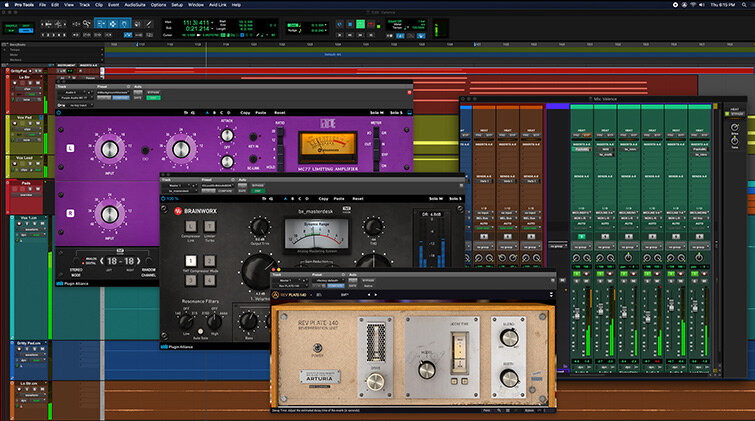
- #BEST OLDER MAC MODEL FOR LIGHT EDITING WITH AVID HOW TO#
- #BEST OLDER MAC MODEL FOR LIGHT EDITING WITH AVID INSTALL#
- #BEST OLDER MAC MODEL FOR LIGHT EDITING WITH AVID FULL#
- #BEST OLDER MAC MODEL FOR LIGHT EDITING WITH AVID PLUS#
Get Interplay to access these clips automatically.Īll you have to do is drop in media directly from the media card or SSD you shot it in, and Avid does the rest in the background while you can carry on doing something else.Link original media or transcoded media to specific bins automatically.Copy to another folder or drive automatically.Imagine this: You create a folder on your computer or another drive that can: This is one of the coolest features of Avid Media Composer. There are some instances where you will need to tell Media Composer which plug-in you intend to use before you work on a specific codec, like in the case of creating profiles for Dynamic Media Folders.

Make sure your installed plug-ins show up here. You’ll get a command-line console, where you type AMA_Listplugins and hit Enter/Return. To check which plug-ins are installed, go to Tools > Console. Once installed, restart Avid Media Composer. You’ll find the available plug-ins and codecs here.
#BEST OLDER MAC MODEL FOR LIGHT EDITING WITH AVID INSTALL#
Unfortunately, Avid has complicated things a bit by requiring you to download and install a different plug-in for each codec. This is Avid’s way of telling you that it can edit files natively, similar to Adobe Premiere Pro.

In this case you’ll need to configure your settings to tell it where things must go. Storage over the Internet, via Interplay Sphereīy default Avid already knows where to store what, unless you have multiple drives or shared storage.Network storage, like a SAN or Avid ISIS.Multiple drives attached to your computer.Single drives attached to your computer.You could choose to write a new file or overwrite the existing backup from the settings.Įverything is stored somewhere, more specifically, hard drives. Avid is actually saving the specific bin in which you’re working, and this is saved as a backup file in a separate folder on your hard drive, under the name ‘Avid Attic’. You can organize multiple bins into folders, which is a handy feature for large projects where bins can get old and need to be archived, etc.Īvid saves your work periodically. These objects can be user-generated (sequences, effects, etc.), imported file-based codecs (AMA) or ingested/captured footage from tape devices (non-AMA).Īvid Media Composer gives you one additional tier of organization, in the form of Folders. Bins can be shared among different editors.Īnything in the bin is an object. When you create sequences, you will be storing them in bins.īins also contain your media, and anything else you can import for your work. It’s just a virtual container for your media files. How data is structured in Avid Media ComposerĪt the core of everything is the ‘bin’, which comes from the film days where film strips, reels and spools were dumped into bins. In this part we’ll look at how Media Composer structures data and media, and the typical workflow.
#BEST OLDER MAC MODEL FOR LIGHT EDITING WITH AVID HOW TO#
In Part One we had a quick overview of the Avid landscape, and how to get help. Please help support wolfcrow and buy from Amazon. Allowing CatDV to manage and search all your media assets and make them available to your Avid editors.Ĭlips and sequences can be simply dragged into Avid by selecting the AAF Tool icon and dropping onto any open Avid bin.įor media playback 3rd party codecs may be requiredįor more information about CATDV, or to place an order, call (310) 922-1631ĭisclosure: Links in this post may be to our affiliates sales through affiliate links may benefit this site. This new tool allows for a complete ‘round trip’ workflow of media and metadata between CatDV and Avid Media Composer. Supported media and metadata is imported to CatDV, the Avid MXF media is relinked and metadata available to all CatDV users. Master clips, subclips and sequences created in Avid Media Composer can be exported to CatDV. Media can be ingested and transcoded using the CatDV Worker and then Pegasus can send the clips to Avid. Shot lists with added meta data can then be prepared off site and then sent to the Avid NLE for editing. Logging clips and sequences can be performed outside of the Avid edit suite saving valuable time and resources.
#BEST OLDER MAC MODEL FOR LIGHT EDITING WITH AVID FULL#
This allows for CatDV to collaborate with Avid Editors as never before, providing a full round trip of media and supported metadata. Supported media is relinked within Avid media Composer. The CatDV AAF Tool supports import of Avid created sequences, Master Clips and Subclips.

Sequences, Master Clips and Subclips can be exported to Avid Media Composer from CatDV. The product is downloadable today.ĬatDV Pegasus provides a complete Avid workflow solution within CatDV. Pegasus can co-exist with CatDV Enterprise clients and is available as a stand-alone product. It also includes metadata support for Red Epic files.
#BEST OLDER MAC MODEL FOR LIGHT EDITING WITH AVID PLUS#
It builds on the foundation of CatDV Enterprise and includes built in support for MXF and archiving plus a brand new solution for integration with Avid Media Composer.


 0 kommentar(er)
0 kommentar(er)
